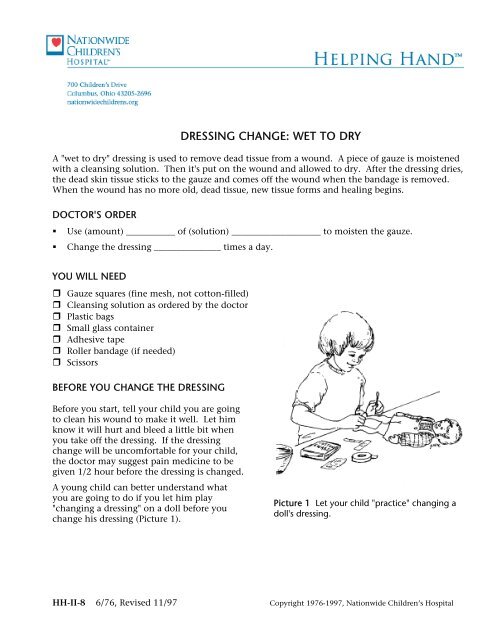In this article, we will provide a comprehensive guide on the correct technique for performing wet-to-dry dressing changes. This crucial aspect of wound care is commonly encountered in various healthcare settings and requires precision and adherence to best practices. By understanding the step-by-step process, healthcare professionals can ensure the effective removal of necrotic tissue and the promotion of healing in the wound. Join us as we explore the intricacies of wet-to-dry dressing changes, providing accurate and factual information to enhance your knowledge and improve patient outcomes.

Understanding Wet-to-Dry Dressing Changes
Wet-to-dry dressing changes are a commonly used wound care technique in medical settings. This method involves applying a moist saline-soaked gauze dressing to a wound, allowing it to dry, and then removing it along with any debris or exudate from the wound surface. This process is repeated on a regular basis to promote wound healing.
What are Wet-to-Dry Dressings?
Wet-to-dry dressings consist of a gauze dressing soaked in a sterile saline solution. This moist dressing is applied directly to the wound bed to promote the removal of dead tissue and debris. As the dressing dries, it adheres to the wound and helps in mechanical debridement, effectively removing any unhealthy tissue from the wound surface.
Why are Wet-to-Dry Dressing Changes Performed?
Wet-to-dry dressing changes are performed for several reasons. First and foremost, they help to cleanse the wound bed by removing any debris, bacteria, or exudate present in the wound. By effectively clearing out these contaminants, wet-to-dry dressings create a healthier environment for wound healing.
Additionally, wet-to-dry dressings promote the growth of new tissue and granulation, which is essential for proper wound healing. The moist environment created by the dressing supports the formation of new blood vessels, facilitates the migration of skin cells, and aids in the healing process overall.
Benefits of Wet-to-Dry Dressing Changes
There are several benefits to using wet-to-dry dressing changes for wound care. Firstly, this technique is versatile and can be used for a wide variety of wound types, including surgical wounds, lacerations, and pressure ulcers. This makes it an excellent choice for healthcare professionals who may encounter different types of wounds in their practice.
Another advantage of wet-to-dry dressing changes is their ability to effectively debride wounds. By mechanically removing dead tissue and debris, these dressings create an optimal environment for wound healing to take place. This debridement process can also help to prevent infection and promote faster healing times.
Additionally, wet-to-dry dressing changes are cost-effective and relatively simple to perform. This makes them accessible to a wide range of healthcare settings and allows for easy integration into wound care protocols.
Preparing for Wet-to-Dry Dressing Changes
Proper preparation is crucial when performing wet-to-dry dressing changes to ensure the best outcomes for patients. Follow these steps to ensure a smooth process:
Gather Necessary Supplies
Before beginning the dressing change, gather all the necessary supplies. This may include sterile saline solution, sterile gauze dressings, adhesive tape, disposable gloves, and a waste receptacle. Having all the supplies within reach will help streamline the procedure and minimize the risk of contamination.
Set up a Clean Workspace
Create a clean and sterile workspace for the dressing change. This can be accomplished by cleaning the surface with a disinfectant solution, ensuring there are no unnecessary items or clutter in the area. A clean workspace reduces the risk of infection and ensures a safe environment for both the healthcare provider and the patient.
Ensure Proper Hand Hygiene
Before beginning the dressing change procedure, it is essential to practice proper hand hygiene. This involves washing hands thoroughly with soap and water for at least 20 seconds or using an alcohol-based hand sanitizer. Hand hygiene is critical in preventing the spread of infection and maintaining patient safety.
Performing Wet-to-Dry Dressing Changes
Following a systematic approach is crucial when performing wet-to-dry dressing changes. This ensures that each step is carried out correctly and reduces the risk of complications.
Step 1: Assess the Wound
Before starting the dressing change, carefully assess the wound. Look for signs of infection, excessive bleeding, or any other deviations from the expected healing process. Document the wound characteristics, such as size, depth, and presence of any odor or exudate. This information will help guide the appropriate treatment and monitor the wound’s progress over time.
Step 2: Gather the Dressing Materials
Prepare the sterile saline solution and gather the sterile gauze dressings. It is important to use sterile materials to minimize the risk of introducing contaminants into the wound. Open the packaging of the gauze dressings without touching the sterile surfaces to maintain their sterility.
Step 3: Put on Gloves
Put on disposable gloves to protect both the healthcare provider and the patient. Gloves create a barrier between the hands and the wound, reducing the risk of cross-contamination and promoting aseptic technique.
Step 4: Remove the Current Dressing
Carefully remove the current dressing from the wound using a gentle, slow motion. Avoid excessive force or pulling, as this can cause damage to the healing tissue. Dispose of the used dressing in the designated waste receptacle.
Step 5: Cleanse the Wound
Cleanse the wound with sterile saline solution or as instructed by the healthcare provider. Using a syringe or an appropriate irrigation device, gently flush the wound with the saline solution to remove any remaining debris or bacteria from the wound bed. This helps create an optimal environment for healing.
Step 6: Dampen the Gauze with Saline Solution
Moisten the sterile gauze dressing with sterile saline solution. Ensure that the gauze is damp but not dripping wet. Too much moisture can soften the wound tissue and impede healing, while too little moisture can cause the dressing to adhere to the wound bed.
Step 7: Pack the Wound
Place the dampened gauze dressing into the wound, ensuring that it covers the entire wound bed. The gauze should be in contact with the entire wound surface to facilitate the removal of debris and exudate during the drying process. Avoid over-packing the wound, as this can inhibit proper airflow and delay wound healing.
Step 8: Cover the Wound
Once the wound is packed, cover it with a clean, dry gauze dressing. This secondary dressing provides additional protection and helps maintain a moist environment within the wound. Secure the dressing in place with adhesive tape, making sure it is snug but not too tight to avoid compromising circulation.
Step 9: Secure the Dressing
Secure the dressing in place with adhesive tape, making sure it is snug but not too tight to avoid compromising circulation. The dressing should remain intact and in place until the next dressing change.
Step 10: Document the Procedure
After completing the dressing change, thoroughly document the procedure in the patient’s medical records. Include details such as the date and time of the change, wound assessment findings, the products used, and any patient responses or concerns. Proper documentation ensures continuity of care and assists in monitoring the wound’s progress.
Addressing Potential Complications
While wet-to-dry dressing changes are generally safe and effective, it is important to be aware of potential complications. Promptly addressing any issues that arise during or after the procedure can help mitigate these complications and ensure the best possible outcomes for the patient.
Infection
Infection is one of the primary concerns when dealing with open wounds. Signs of infection include increased redness, swelling, warmth, or a foul odor coming from the wound. If any of these signs are present, it is crucial to notify the healthcare provider and initiate appropriate treatment, such as topical or systemic antibiotics.
Excessive Pain or Bleeding
If the patient experiences excessive pain or bleeding during the dressing change, it is important to stop the procedure and assess the wound. Pain or bleeding may indicate an underlying issue, such as improper technique or wound complications. Consulting with the healthcare provider and addressing any pain or bleeding promptly will ensure patient comfort and safety.
Allergic Reactions or Irritation
Some individuals may develop allergic reactions or irritation to the dressings or cleansing agents used during the procedure. If the patient experiences any unusual or concerning symptoms, such as itching, redness, or a rash, it is essential to discontinue the dressing and seek medical advice. The healthcare provider can recommend alternative dressing options or medications to address the allergic reaction.
Delayed Wound Healing
In some cases, wound healing may be delayed despite appropriate dressing changes. This may be due to underlying factors such as poor nutrition, inadequate blood supply, or the presence of comorbidities. If wound healing does not progress as expected, it is important to consult with the healthcare provider for further evaluation and management.
Additional Tips for Success
To ensure the success of wet-to-dry dressing changes, consider the following additional tips:
Consistency and Frequency
Consistency and frequency are important in maintaining an optimal healing environment for the wound. Follow the healthcare provider’s instructions regarding the frequency of dressing changes and adhere to a regular schedule. Consistency in the dressing change process promotes proper wound care and reduces the risk of complications.
Communication with Healthcare Provider
Effective communication with the healthcare provider is key in providing appropriate wound care. Report any changes or concerns regarding the wound’s appearance, symptoms, or healing progress. Collaborate with the healthcare team to develop an individualized plan of care that addresses the patient’s specific needs and promotes optimal wound healing.
Regular Wound Assessment
Regularly assess the wound between dressing changes to monitor its progress. Look for signs such as reduced redness, decreased wound size, and the emergence of healthy granulation tissue. Document these findings and communicate them to the healthcare provider. Regular wound assessment helps track the effectiveness of the dressing changes and guides further treatment decisions.
In conclusion, wet-to-dry dressing changes are a widely used technique in wound care. Understanding the purpose, benefits, and proper procedure for wet-to-dry dressing changes is crucial for healthcare professionals involved in wound care. By following the recommended steps, addressing potential complications, and maintaining open communication with the healthcare team, healthcare providers can promote optimal wound healing and improve patient outcomes.

